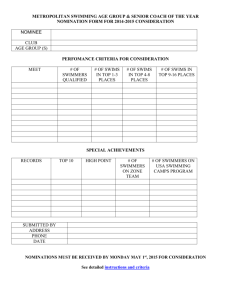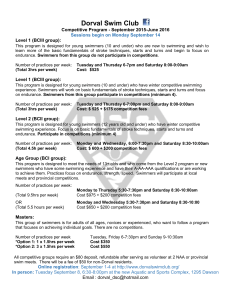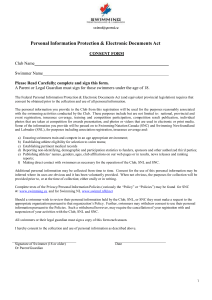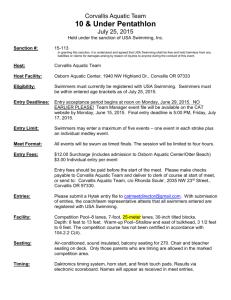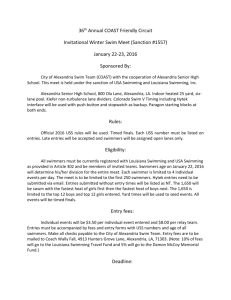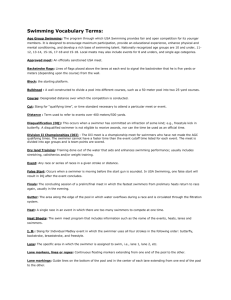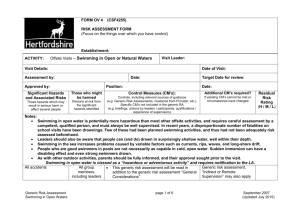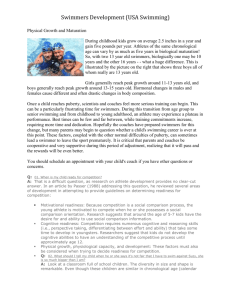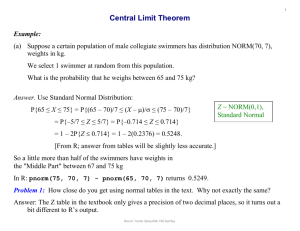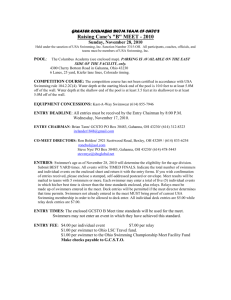Understanding Long Term Athlete Development (LTAD) in Swimming
advertisement
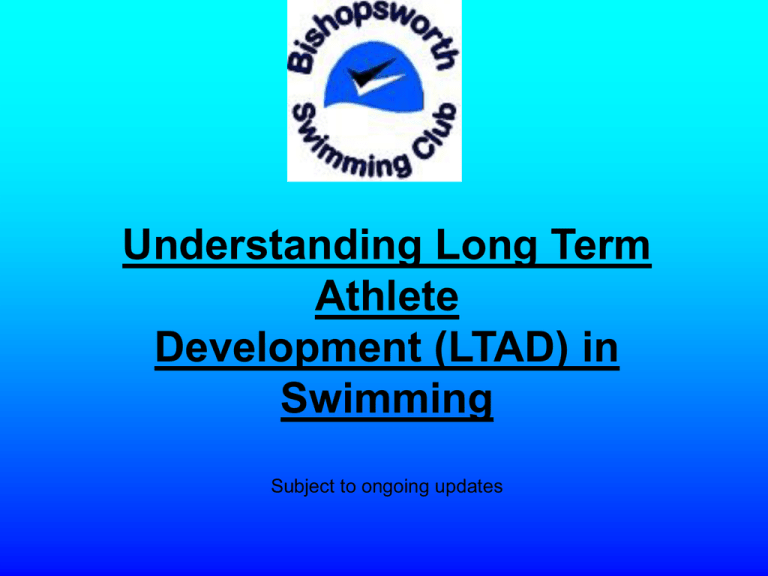
Understanding Long Term Athlete Development (LTAD) in Swimming Subject to ongoing updates Skill Development Because athletes lock in their skills during the first three to four years of swimming, the emphasis should not be on how fast you swim but how well you swim. To avoid injury, improve motor learning skills, increase interest and benefit long term development, multi-stroke, multi-event swimming is paramount. It is important to understand that skills and physiological capacities acquired while young will impact upon later stages of development. For example, stroke technique is much harder to modify after many years of ‘doing it that way’. Endurance and strength develop steadily during childhood; therefore, the physical demands of training should increase in a logical manner. Individual swimmers often demonstrate mastery of a few advanced skills; however, until they have mastered all (or nearly all) the skills at their current training level they are not ready to undertake a more advanced program. Three important concepts should be noted. 1. Each training period will have a major emphasis 2. It is important that both mastery and retention of lower level skills and fitness are carried forward to the next training period. 3. Training generally progresses by first increasing the volume of work, then the frequency of training sessions, and finally the intensity of training. Age is Relative Every child will mature at a slightly different rate. Child development research can indicate the likely chronological age at which certain abilities are acquired, however, any two 10 year-old swimmers may be 1-2 years apart in their biological ages. For example, a late maturing 12 year old girl might best fit into the training plans developed for a group of mostly 10-11 year-olds. Conversely, the 12 year old girl who has completed her growth spurt may be capable of meeting the training expectations of a more advanced training level. Since late developers often catch and surpass early developers, coaches, parents and swimmers must learn to remain patient and enjoy the lifelong benefits that swimming has to offer. Types of Energy For many years the way that the body produces energy has been known. For adults, in short events e.g. less than 45 seconds in duration, energy is derived predominantly anaerobically. For longer events e.g. greater than 1 minute 30 seconds energy requirements are derived predominantly aerobically. For events between 45 seconds and 1 minute 30 seconds energy is provided through both aerobic and anaerobic metabolism. Prior to puberty, the greatest proportion of a young person's energy is derived aerobically. Anaerobic metabolism, as a proportion of overall energy output, is small. After puberty, aerobic capacity increases significantly, and an increased proportion of the overall energy requirements are met from anaerobic metabolism. Therefore, energy derived aerobically is very important in swimming. Male Adulthood (18+) Early Adulthood (15 to 18) Adolescence (12 to 15) Late Childhood (9 to 12) Childhood (6 to 9) Female Training to Win Training to Compete Training to Train Swimskills FUNdimentals Please Note; the physical development ‘age’ is more important than the ‘actual’ age for moving on to the next stage. All ages above can be up to +/- 2 years depending on the child. Adulthood (16+) Early Adulthood (14 to 16) Adolescence (11 to 14) Late Childhood (8 to 11) Childhood (5 to 8) Long Term Athlete Development (LTAD) is a concept that is now at the heart of competitive swimming and training in Great Britain and it is one which Bishopsworth Swimming Club aims to incorporate at the heart of the club. It is based on a scientific understanding of how a childs body grows, changes and develops and the most appropriate type of training and competition for that developing body. It recognises, for example, that what would be appropriate training for a young adult whose major growth spurt was nearly over and whose muscles were developed enough to be working on strength training, would not be right for someone in late childhood whose body had not yet gone through those changes - and that it could in fact cause serious damage. Throughout a swimmers development it emphasises the refinement and development of swimming skills, particularly in the earlier stages, as the sound foundation on which to develop once the body has matured sufficiently. Whilst it is possible to train younger bodies harder to achieve early success, particularly those who are early developers, the danger is that without a solid technique foundation they will find themselves overtaken by those who have taken a more patient route, or even worse, will be forced to give up because of ‘burnout’ or injury. It aims to avoid trying to produce children who peak at 11 or 12 - but who have given up swimming by 14. Its aim is to ensure that swimmers will be able to reach their genetic potential as they mature based on a solid skill foundation, with healthy, well trained bodies and the mental skills and confidence to be still enjoying their swimming. Virtually all young people will follow the same pattern of growth from infancy through adolescence to adulthood, but there can be significant individual differences in both the timing and magnitude of the changes that take place both mentally and physically and girls also tend to develop earlier than boys. For this reason the ages used are only guidelines - the physical stage of development of the child is much more important. FUNdimentals Age: Female: 5 to 8 years; Male: 6 to 9 years. • The FUNdamentals stage aims to be structured and fun because a child's attention span is short and there is a strong need for positive re-enforcement. • Growth at this age is rapid due to the development of large muscle groups, and therefore the emphasis should be on developing basic movement literacy and fundamental movement skills. • The skills to be developed are the ABCs (Agility, Balance, Coordination, Speed), RJT (Running, Jumping, Throwing), KGBs (Kinaesthetics, Gliding, Buoyancy, Striking with the body) and CPKs (Catching, Passing, Kicking, Striking with an implement). In order to develop basic movement literacy successfully, participation should be encouraged across as many different activities as possible. • As the size of the heart increases in relation to the rest of the body, endurance should be developed using FUN and games. In addition, children should be introduced to the simple rules and ethics of sports to complement the beginning of their understanding into the need for rules and structure. • These activities should be part of well structured programmes with proper progressions that are monitored regularly. • Above all else, children should have FUN and be active during this stage. Swimskills • AGE: Female: 8 to 11 years; Male: 9 to 12 years. • During the SwimSkills period, the nervous system is almost fully developed and there are rapid improvements in the co-ordination of movement skills. • As a result, young people should learn how to train and develop sport specific skills. This is a good time to work on developing excellent technique in all four strokes as well as starts, turns and finishing skills. A multi stroke approach to training and competition will not only reduce the likelihood of injury but also ensure interest levels will remain high with the result that swimming should continue to be fun. • It is often a good idea to participate in complementary sports i.e. those sports, which use similar energy systems and movement patterns. • Training should include the use of 'own body weight' exercises; medicine ball and Swiss ball exercises as well as developing suppleness. Swimmers should also learn the basic technical and tactical skills which include; warm up and cool down; stretching; hydration and nutrition; recovery; relaxation and focusing. • Although the focus is on training, competition should be used to test and refine skills. The recommended training to competition ratio is 75% to 25% over one swimming year. • If a young swimmer misses this stage of development then he/she is unlikely to reach their full potential. • One of the main reasons athletes plateau during the later stages of their careers is because of an over emphasis on competition instead of taking full advantage of training during this very important stage which may produce an initial rapid increase in performance, but a lower level of achievement and early retirement. Studies have also shown that swimmers who do not develop early may have a slower initial increase in performance, but they can ultimately reach a higher level of achievement and are more likely to have a longer life in the sport. Training to Train • AGE: Female: 11 to 14 years; Male: 12 to 15 years. • During the Training to Train stage, there should be an emphasis on aerobic, or endurance, conditioning. The cardio-vascular system, determines the efficiency of the heart and lungs. These organs are developed through building up work on longer distances. Swimming is an endurance sport - most events last 45 seconds or more and none are similar to the 100m track event, which lasts a few seconds. Training and competition for young swimmers should therefore have an endurance base. Even at senior level it is common practice for swimmers in the sprint events (50 and 100m) to train and compete in the distance above (200m). It is recognised that a swimmer may compete successfully at a distance "down" (shorter) but that it is very difficult to compete successfully in an event, which is a distance up (longer). • This should be the stage of greater individualisation of fitness and technical training. The focus should still be on training rather than competition and the training should be predominantly of high volume, low intensity workloads. It is important to emphasise high volume, low intensity training cannot be achieved in a limited time period, and therefore the time commitment to training is likely to increase significantly. As the volume of training increases there is likely to be a reduction in the number of competitions undertaken. However, there should now be specific targets for each competition, with a view to learning basic tactics and mental preparation. There should be either one or two training cycles during the year. • During this stage, training should continue to develop suppleness and to include the use of 'own body weight' exercises; medicine ball and Swiss ball exercises. However towards the end of this stage, preparations should be made for the development of strength, which for girls occurs at the end of this stage and for boys at the beginning of the next stage. This should include learning correct weight lifting techniques without any resistance; the knowledge base of how to warm up and warm down; how and when to stretch; how to optimise nutrition and hydration; mental preparation; regeneration; how and when to taper and peak; pre-competition, competition and post competition routines. Similar to the previous stage, if insufficient time is devoted to this stage or it is missed, the young swimmer is unlikely to reach their full potential. Training to Compete AGE: Female: 14 to 16 years; Male: 15 to 18 years. • During the training to compete stage there should be a continued emphasis on physical conditioning with the focus on maintaining high volume workloads but with increasing intensity. The number of competitions should be similar to the end of the previous stage but the emphasis should be on developing individual strengths and working on weaknesses. • This should be achieved through practising technical and tactical skills based around specific strokes at all distances, or specific distances across a range of strokes. • Although the muscular system develops throughout childhood and adolescence, significant strength gains tend not to respond to training until after puberty. Therefore, training should also focus on developing strength gains through the use of weights, but only when the correct lifting techniques have been learned. This should be coupled with continued work on core body strength and maintaining suppleness. Training to Win AGE: Female: 16+ years; Male: 18+ years. • This is the final stage of athletic preparation. The emphasis should be on specialisation and performance enhancement. All of the swimmers physical, technical, tactical, mental, and ancillary capacities should now be fully established with the focus shifting to producing the best possible performance. • Swimmers should be trained to peak for specific competitions and major events. Therefore, all aspects of training should be individualised for specific events. There should be two, three or more training cycles, depending on the events being trained for. During this stage, training should continue to develop strength, develop core body strength and maintain suppleness.
